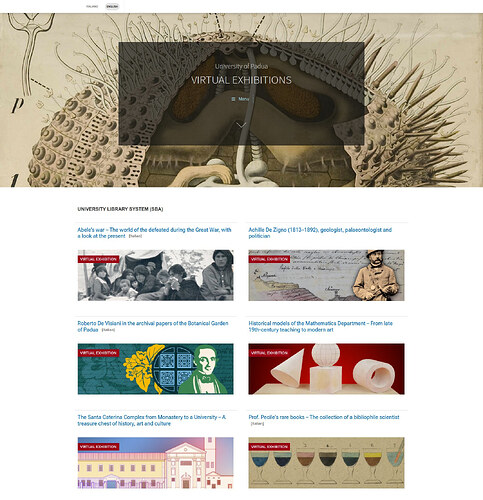Our second community call on July 3rd 2025 was again well attended by around 25 people. Thank you all for being there and thanks above all to our speakers Dragana, Arran and Gianluca. With their help and a transcription of the call, we created the following summary:
Dragana Stolić, PhD Studies Support Centre, University Library “Svetozar Markovic”, Belgrade, Serbia
- Dragana discussed the evolution and challenges of PHAIDRA, repository system of the University of Belgrade.
- PHAIDRA - Digital repository of the University of Belgrade, established in 2011, serves as a mandatory archiving solution for theses at the University. Dissertations from faculties are archived in PHAIDRA through the library, which is for permanent archiving of dissertations and other works.
- A new PHAIDRA (PHAIDRA Research) was established a few years ago (discussed at Vienna in 2022) for institutions outside the University of Belgrade. It aims to be a transfer path to the national portal eScience, which gathers data from all Serbian repositories for evaluation and valorisation of scientific work. Both repositories - PHAIDRA of the University of Belgrade and PHAIDRA Research - now have almost 30 collections from other institutions, and this number is increasing.
- Plans are underway for a third PHAIDRA, named PHAIDRA Milagro, as part of a project focusing on migrations and connections between local communities and migrants. This will be a distinct subject repository, unlike the previous multidisciplinary, institutional ones. Dragana plans to discuss the Milagro project at the PHAIDRA conference.
- Since 2015, Serbia has undergone a “repositorization” process, where, in addition to the university-wide PHAIDRA, the majority of the faculties at the University of Belgrade established their repositories (using DSpace) for evaluation purposes.
- A key strategic challenge revolves around whether a centralised approach (one joint university repository like PHAIDRA) or a decentralised approach (individual faculty repositories) is better, with pros and cons for both. Factors include the differences in outputs and specific data requirements between faculties (e.g., Philosophy versus Pharmacy) and the costs, maintenance, and technical support involved with decentralised systems.
- Other challenges include migrating data between DSpace and PHAIDRA and the need to adjust PHAIDRA to meet the requirements of the national eScience system (basically DSpace with CRIS extension)
- Despite these challenges, PHAIDRA has existed for over 10 years and is increasingly used by institutions. Its continued success is attributed to its qualities of simplicity, reliability, and durability. The system remains open to other users and institutions to join.
- Some faculties use both PHAIDRA and their solutions in parallel. There is consideration among some to revert to PHAIDRA systems, possibly due to economic aspects like maintenance. The PHAIDRA system positions itself as an open and available repository for the university and other institutions in Serbia.
Arran Griffith, Fedora Program Manager
- Arran clarified that while the National Library of Medicine (NLM) doesn’t deploy PHAIDRA, they have an active implementation of Fedora and are in the progress of migrating from Fedora 3.8 to Fedora 6.x. Arran presented some of the Fedora-related challenges that NLM has faced during their migration. Fedora 6 is a core component of the PHAIDRA stack, meaning updates and challenges in Fedora can affect PHAIDRA users.
- Arran provided updates on the Fedora program’s activities and future plans.
- Upcoming events include a virtual presentation at Islandora Con, the Fedora Camp (an in-person event in September at the University of Vienna, with open registration and call for presentations), an annual virtual Fedora Showcase in October, and a hopeful trip to PHAIDRAcon in October.
- The Fedora community is nearing the end of a large-scale dependency project to update outdated libraries, which will result in a more secure, stable, and modern Fedora 7 release (requiring no migration from Fedora 6).
- They are investigating transaction-related issues reported by community members and will host two open community sessions on 22nd and 23rd July to address these.
- Future development efforts will be prioritised based on community input gathered through open sessions, with some funding from Lyrasis to support these initiatives.
- Arran highlighted Fedora’s flexibility through diverse use cases:
- Arminda (Whitman College): An institutional repository that successfully migrated from Fedora 3 to Fedora 6 using an Islandora 2.0 front-end.
- DesignSafe (Texas Advanced Computing Center): A research repository using Fedora 5 in a high-performance computing environment to curate and preserve large volumes of natural hazard scientific data, noting Fedora’s role in its Core Trust Seal certification and planned migration to Fedora 6 to leverage OCFL.
- Archives of the Republic of Slovenia: Uses Fedora 6 with ScopeArchiv for the preservation and specialised access to digitised public archives.
- Arran then detailed the National Library of Medicine’s (NLM) use case and challenges.
- NLM is the largest medical library in the United States, managing 175 terabytes of diverse collections (6 million Fedora 3 objects) and still running Fedora 3.8.1 in production.
- Their goal is to migrate their backend to Fedora 6 in an AWS cloud environment, leveraging OCFL and migration tools.
- Key challenges included:
- A management mandate to migrate everything (on-prem to AWS, Fedora 3 to Fedora 6) all at once, increasing risk and requiring significant architecture build-out.
- The multi-step migration process was complex, time-consuming, and resource-heavy, often requiring repetitions. They addressed this by dividing data into chunks and using parallelisation for ingest. They noted some data loss in batch uploads but have master copies.
- File size growth due to OCFL’s mandatory accompanying files required optimisation and additional hardware.
- Initial performance issues with S3 as primary storage for OCFL led them to switch to EFS, which significantly improved performance.
- Difficulties replicating their repository across test, development, and production instances due to OCFL root not generating correctly, possibly related to indexing timing issues.
- The slide deck from the presentation can be found here: Fedora Community Update
- Arran noted that the Fedora program is also active on the PHAIDRA discourse platform, or you can contact her at arran.griffith@lyrasis.org, or the Program Developer, Dan Field at dan.field@lyrasis.org.
Gianluca Drago, Librarian at University of Padua
At the University of Padua, the desire to preserve, study and share cultural heritage has led to the creation of numerous digital exhibitions, designed to make collections more accessible and engaging for a broad audience. While the university uses the Phaidra platform to store and manage its digital collections, including materials from libraries, archives and museums, Phaidra alone doesn’t offer the narrative flexibility or interactive features suited for public engagement.
To overcome this limitation, the university launched a virtual exhibitions project, aimed at transforming collections into storytelling experiences. Over the last ten years, around 30 exhibitions have been developed by libraries, museums, departments, and research centres. These exhibitions focus on specific topics, figures, or library collections from Padua’s academic and cultural history — from botanical illustrations and the rise of modern medicine, to 20th-century Resistance documents.
The tool behind these exhibitions is Movio, an open-source content management system developed under the coordination of the Italian Ministry of Culture. Movio was chosen for its intuitive interface and toolkit, which allows non-technical users to create rich, interactive exhibitions. It supports features such as timelines, interactive maps, image galleries, video content, and dynamic charts, all of which contribute to a more immersive visitor experience.
Though Movio is under slow development and has a limited user community, it remains a practical solution for many cultural institutions in Italy. Alternatives like Omeka, which enjoy greater international adoption and continued development, are also recognized, but Movio’s ease of use made it the preferred choice at Padua.
For Padua, the goal is to achieve the best possible integration between the two platforms, Phaidra and Movio. To this end, several enhancements have been made to the software, in particular the implementation of API-based communication that enables the direct import of Phaidra objects or entire collections into the virtual exhibition environment in the simplest and most automated way possible.
Ultimately, these digital exhibitions reflect the curators’ passion for their materials and their commitment to knowledge dissemination, part of the university’s Third Mission — bringing academic research to the public in accessible and engaging ways.
The next community call is about “Development Updates & Roadmap Discussion”. In principal it is scheduled for Thursday, August 21: 16:00-17:00. I will try to get an interesting program together and check availability of people taking into account the holiday season.
Keep an eye on this platform for updates.


